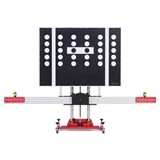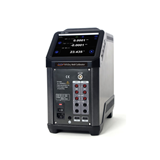Metal detectors play a crucial role in various industries by ensuring the safety, quality, and compliance of products and processes. Regular maintenance and calibration of these devices are of paramount importance to uphold their efficiency and reliability. In this section, we will explore the significance of adhering to a maintenance schedule and the role of food metal detectors in Sydney across different sectors.
A. Importance of Regular Maintenance and Calibration
- Maintaining the Performance Integrity: Regular maintenance guarantees that the food metal detector continues to operate at its peak performance. It helps to preserve the sensitivity and accuracy of the device, ensuring that no metal contaminants go undetected.
- Enhancing Product Safety: In industries such as food processing and pharmaceuticals, where contamination can have severe consequences, adhering to a maintenance routine is essential. It minimizes the risk of contaminated products reaching consumers, safeguarding public health.
- Compliance with Industry Standards: Many industries have stringent regulations and standards pertaining to product safety and quality. Regular maintenance is a key factor in meeting these requirements and passing inspections and audits.
- Cost-Effectiveness: Investing in preventive maintenance is more cost-effective than dealing with unexpected breakdowns. Timely servicing can identify and address minor issues before they escalate into major problems, saving both time and money.
B. Overview of the Metal Detector's Role in Various Industries
- Food and Beverage Industry: Metal detectors are widely used to detect metal contaminants in raw materials, ingredients, and finished products. Ensuring metal-free products is critical to prevent product recalls, protect brand reputation, and comply with food safety regulations.
- Pharmaceutical Industry: In pharmaceutical manufacturing, metal detectors are essential for identifying metal particles that might inadvertently enter the production process. Maintaining a hygienic and contaminant-free environment is vital to guarantee the quality and efficacy of pharmaceutical products.
- Mining and Extraction: Metal detectors are employed to locate and extract valuable metal ores efficiently. Regular maintenance of the detectors ensures continuous productivity and minimizes downtime in mining operations.
- Security and Public Safety: Metal detectors are commonly used in airports, government buildings, and public venues to screen individuals for potential weapons or dangerous items. Calibration and maintenance are crucial to maintain the accuracy of these security measures.
1. Implementing Regular Maintenance Schedule and Best Practices
A. Understanding the Frequency of Maintenance
Regular maintenance is essential to ensure the optimal performance and longevity of metal detectors.
The frequency of maintenance depends on various factors, including:
- Usage intensity: Heavy-duty operations may require more frequent maintenance.
- Operating environment: Harsh or dusty environments may necessitate more frequent checks.
- Manufacturer's recommendations: Adhere to the maintenance schedule provided by the manufacturer.
Conduct a risk assessment to determine the appropriate maintenance intervals.
Consider the consequences of potential equipment failure to establish a suitable maintenance frequency.
B. Creating a Maintenance Checklist
Developing a comprehensive maintenance checklist helps maintain consistency and accuracy in the maintenance process.
Include the following items in the maintenance checklist:
- External inspection: Check for physical damage, loose connections, and signs of wear.
- Electrical components: Inspect cables, connectors, and power supply for any issues.
- Calibration verification: Regularly test and recalibrate the metal detector to ensure accurate detection.
- Signal testing: Verify the detector's response to different metal types and sizes.
- Conveyor belt examination (if applicable): Inspect for any damage or misalignment.
- Documentation: Keep records of maintenance tasks, dates, and any issues encountered.
Review and update the maintenance checklist periodically to incorporate any lessons learned.
C. Training Staff for Proper Maintenance Procedures
Proper training is crucial to ensure that maintenance tasks are carried out effectively and safely. Identify key personnel responsible for maintenance and provide them with specialized training.
Training should cover the following aspects:
- Understanding the metal detector's components and their functions.
- Step-by-step maintenance procedures.
- Safety precautions and the use of personal protective equipment (PPE).
- Encourage staff to ask questions and seek clarification during the training sessions.
- Schedule refresher courses to keep maintenance skills up-to-date and reinforce best practices.
- By adhering to a well-structured maintenance schedule and implementing best practices, you can ensure that your metal detectors function optimally and minimize the risk of downtime and false detections
2. Ensuring Proper Cleaning and Sanitization for Hygienic Applications
A. Importance of Cleanliness in Food and Pharmaceutical Industries
Maintaining a high level of cleanliness is paramount in food and pharmaceutical industries to ensure product safety and compliance with regulations.
Contamination of products can lead to serious health risks for consumers and legal consequences for manufacturers. Cleanliness directly impacts the quality and purity of the final products, making it essential for maintaining brand reputation and consumer trust.
B. Recommended Cleaning Agents and Techniques
Use of FDA-approved cleaning agents and disinfectants is crucial to prevent any harmful chemical residues on the metal detector surfaces. Non-toxic and non-reactive cleaning agents should be employed to avoid any adverse reactions with the materials used in the metal detector construction.
Regularly follow the manufacturer's guidelines and recommendations for cleaning to avoid damage to sensitive components and ensure effective cleaning.
C. Sanitization Guidelines and Best Practices
Establish a detailed sanitization protocol that includes step-by-step procedures for cleaning and disinfecting metal detectors.Train personnel in proper sanitization practices, ensuring they understand the importance of adherence to the established guidelines. Implement a schedule for periodic deep cleaning and sanitization based on the level of usage and the nature of the application.
3. Conducting Calibration and Performance Verification of Metal Detectors
A. Understanding Calibration and its Significance
Calibration is a critical process that ensures the accuracy and reliability of a metal detector's readings. It involves comparing the instrument's output to a known standard to determine any deviations. Calibration guarantees that the metal detector is operating within acceptable limits and provides trustworthy results.
B. Calibration vs. Performance Verification: Key Differences
Calibration focuses on adjusting the metal detector to match a reference standard, eliminating any systematic errors. Performance verification, on the other hand, aims to confirm whether the metal detector is performing up to its specified standards without adjustments. Calibration is a proactive process, while performance verification is a reactive assessment of the metal detector's current state.
C. Step-by-Step Calibration Procedure
Preparing the Metal Detector
- Ensure the metal detector is clean and free from any debris that could interfere with the calibration process.
- Verify that the metal detector is in the "idle" or "standby" mode before starting the calibration.
Selecting the Calibration Standard
- Choose a calibration standard that closely matches the type of contaminants typically encountered in your application.
- The standard should have a known and precise size to provide accurate calibration results.
Positioning the Calibration Standard
Place the calibration standard in the center of the metal detector's aperture, maintaining the same orientation throughout the process.
Initiating the Calibration Process
- Follow the manufacturer's instructions to access the calibration menu or mode.
- Input the relevant parameters, such as the standard's size and material, into the metal detector's interface.
Running the Calibration
- Allow the metal detector to perform the calibration process automatically.
- The system will compare the signals generated by the calibration standard with the expected values and make necessary adjustments.
Verifying Calibration Results
- After calibration, perform a test using a certified test sample to ensure the accuracy of the metal detector's readings.
- Document the calibration results and any adjustments made during the process.
Establishing Calibration Frequency
- Consult the manufacturer's guidelines or industry standards to determine how frequently the metal detector should undergo calibration.
- Factors such as operating conditions, the criticality of the application, and the metal detector's historical performance should be considered.
4. Inspecting and Replacing Components as Needed
A. Identifying Critical Components for Inspection:
The metal detector's performance relies on several key components, which necessitate regular inspection to ensure optimal functionality.
Critical components that require inspection include:
- Control Panel: Assess the control panel for any signs of damage, loose connections, or unresponsive buttons.
- Conveyor System: Check the conveyor belt or system for wear, tear, misalignment, or any abnormalities that may affect the product's passage.
- Coil Assembly: Inspect the coil assembly for physical damage, cracks, or coil misalignment, as these can impact detection accuracy.
- Reject System: Evaluate the reject mechanism to confirm it operates correctly when metal contaminants are detected.
- Power Supply and Cables: Examine power supply units and cables for any fraying, loose connections, or malfunctions.
B. Signs of Wear and Tear: When to Replace Parts:
Regularly monitoring the metal detector for signs of wear and tear is essential to prevent potential breakdowns and maintain accurate detection.
Some common signs of wear and tear include:
- Reduced Sensitivity: When the metal detector becomes less sensitive and fails to detect contaminants effectively.
- False Alarms: Frequent false alarms or inconsistencies in detection performance may indicate component deterioration.
- Physical Damage: Obvious physical damage, such as cracks, dents, or bent parts, may necessitate immediate replacement.
- Unusual Noises: Uncharacteristic noises during operation may indicate issues with internal components.
- Inconsistent Conveyor Movement: Irregular movement or misalignment of the conveyor system may signal underlying problems.
C. Sourcing and Installing Replacement Components:
When replacing components, it is crucial to use genuine parts provided by the metal detector manufacturer to maintain performance and ensure safety.
Follow these steps for sourcing and installing replacement components:
- Contact the Manufacturer: Reach out to the manufacturer or authorized distributors to acquire genuine replacement parts.
- Obtain Technical Guidance: Seek technical guidance from the manufacturer's support team or documentation to ensure proper installation.
- Power Down and Isolate: Before replacing any component, power down the metal detector and isolate it from the power source to prevent accidents.
- Follow Installation Procedures: Adhere to the manufacturer's recommended installation procedures, using appropriate tools and techniques.
- Test and Calibrate: After component replacement, conduct thorough testing and calibration to verify the metal detector's accurate functionality.
5. Addressing Environmental Factors Impacting Metal Detector Performance
A. Understanding Environmental Challenges
- Metal Detector Sensitivity: Environmental factors can affect the sensitivity of metal detectors, leading to false positives or false negatives. Understanding these challenges is crucial for maintaining accurate detection.
- Temperature and Humidity: Extreme temperatures and high humidity levels can impact the performance of metal detectors, altering their sensitivity and stability.
- Electromagnetic Interference: Environmental electromagnetic noise can interfere with metal detector signals, causing inaccurate readings and reduced detection capability.
B. Minimizing Interference from External Factors
- Proper Shielding: Installing electromagnetic shielding around metal detectors can help reduce external interference and maintain consistent performance.
- Grounding: Effective grounding of metal detectors helps to mitigate the impact of electromagnetic interference, ensuring accurate detection.
- Signal Adjustment: Employing advanced signal processing techniques allows metal detectors to filter out unwanted noise and focus on relevant signals.
C. Maintaining Optimal Operating Conditions
- Regular Calibration: Calibrating the metal detector at regular intervals ensures that it is operating at its peak performance, accounting for any changes in the operating environment.
- Routine Inspection: Periodic inspections help identify and address environmental wear and tear, ensuring the system remains in top condition.
- Environmental Monitoring: Implementing a monitoring system to track temperature, humidity, and electromagnetic conditions aids in identifying potential issues proactively.
6. Complying with Industry Standards and Regulations for Metal Detectors
A. Overview of Relevant Industry Standards
- Understanding Applicable Standards: Different industries have specific standards for metal detector performance, sensitivity levels, and operational practices.
- National and International Standards: Familiarizing with both national and international standards is essential for businesses operating in global markets.
B. Importance of Compliance in Different Sectors
- Food Safety: Compliance with industry standards ensures that metal detectors in the food industry meet strict safety regulations, preventing metal contamination in products.
- Pharmaceutical Quality Control: Adhering to industry standards is critical for pharmaceutical companies to maintain product integrity and meet quality control requirements.
C. Ensuring Legal Requirements are Met
- Compliance Audits: Regular compliance audits help identify areas of improvement and ensure adherence to relevant regulations.
- Record Keeping: Maintaining detailed records of maintenance, calibration, and inspection activities demonstrates a commitment to compliance and accountability.
7. Extending the Lifespan of Metal Detection Equipment through Effective Maintenance
A. Cost-Benefit Analysis of Regular Maintenance
- Long-term Savings: Investing in regular maintenance can significantly reduce the risk of equipment failure, minimizing downtime and repair costs.
- Enhanced Reliability: Well-maintained metal detectors offer consistent and reliable performance, reducing the likelihood of false alarms and production interruptions.
B. Maximizing Return on Investment (ROI) through Extended Equipment Life
- Prolonging Equipment Life: Proper maintenance practices extend the operational life of metal detection equipment, maximizing the return on the initial investment.
- Future-Proofing: By ensuring the equipment remains effective, businesses can avoid premature replacements and save on capital expenses.
C. Long-term Strategies for Equipment Maintenance
- Planned Maintenance Schedules: Implementing a comprehensive maintenance schedule helps organizations stay on top of necessary upkeep and inspections.
- Training and Knowledge Transfer: Equipping maintenance personnel with the necessary skills and knowledge ensures effective care of the metal detection equipment.
In conclusion, food metal detectors hold indispensable roles across diverse industries, contributing to safety, quality assurance, and regulatory compliance. Regular maintenance and calibration are paramount to uphold the efficiency and dependability of these devices. This section delved into the importance of adhering to maintenance schedules, inspecting critical components, addressing environmental challenges, and complying with industry standards.

















